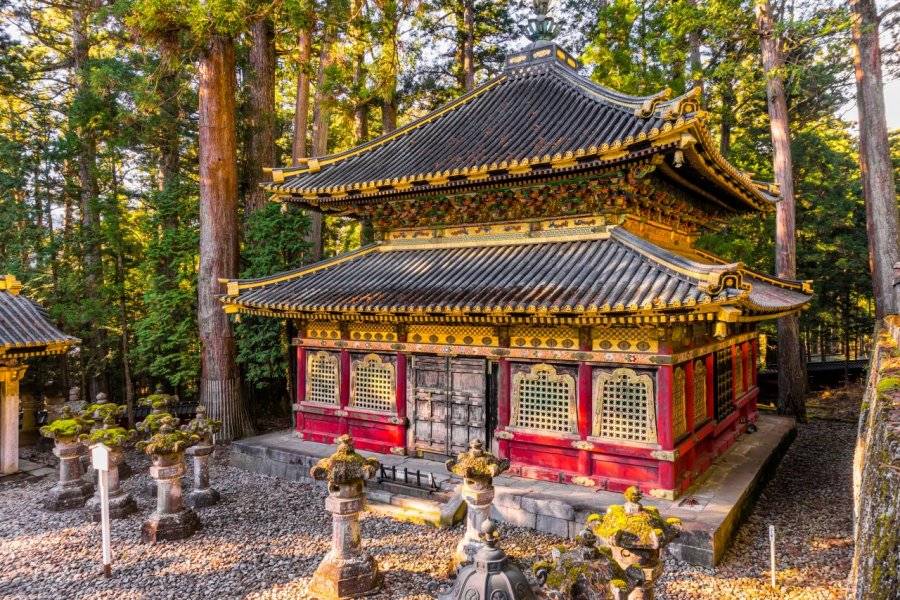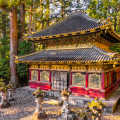Nestled in a magnificent cedar forest, the Tōshō-Gū Shrine is Nikkō's flagship tourist site. It is a Unesco World Heritage Site. Built in 1636 as a mausoleum for Shogun Ieyasu Tokugawa, it is typical of the Momoyama style, with its unusual carvings, gilding and flashy colors. At the time of its construction, it was a considerable and costly project, which was completed in less than two years. Numerous buildings are revealed along the way, including the shogun's mausoleum and a five-level pagoda. Heading north from Ōte-dōri, the Sennin ishidan stone staircase leads to the 8m-high granite torii. Immediately to the left of the latter is the five-storey pagoda, some 30 m high, built in 1650 and rebuilt in 1818. Each floor represents one of the elements (earth, fire, water, wind and sky). The architrave on the second floor is decorated with the signs of the Chinese zodiac. On each floor, black lacquer doors bear the Tokugawa coat of arms. A staircase leads to the Omote-mon door. On the lintels and pillars, various sculptures depict flowers and the heads of baku, the creature that devours dreams. The gate is guarded by Deva statues. Immediately beyond are the three sanjinko (sacred stores) and, to the left of the portal, the shinkyūsha (sacred stable), housing a carved white horse. The ornaments, made of relief carvings, represent three monkeys that are the horse's guardian spirits. As you approach the rinzō, a pool of lustrous water. Here you'll find a sutra library containing over 7,000 Buddhist scriptures. Another staircase leads to a terrace featuring a large candelabra and two lanterns donated by the Dutch through François Caron. Behind the Drum Tower, the Honji-dō is a vast space dedicated to Yakushi Nyorai (one of the representations of Buddha). The ceiling was decorated with a huge painting, the Moaning Dragon (Nakiryū), which seemed to whimper when you clapped your hands beneath it. After its destruction in 1961, a contemporary artist, Nampu Katayama, was asked to repaint the dragon.
Yōmei-mon. After another flight of steps, you reach the famous gate that some call the jewel of Japanese architecture. It was at this gate that lower-ranking samurai stopped, while higher-ranking samurai could pass beyond after laying down their swords. It's also known as the twilight gate, as it was supposed to hold the visitor's attention and dazzle until nightfall. The two-storey portal is supported by twelve white-painted elm columns. On the beams are medallions or bas-reliefs in which characters, animals, flowers, trees, fruit and the famous tigers, whose fur is recreated with incredible finesse using woodworking techniques. Motifs are carved upside down to ward off bad luck. On the central beam of the second floor is a dragon, and there are two other dragons on the ceiling. Once past the Yōmei-mon, you enter another courtyard separated from the sanctuary by an enclosure.
Kara-mon. This new gateway leads to the Hai-den and Hon-den. It is also decorated with numerous ornaments, flowers and dragons, carved on the pillars and casements. The ceiling is decorated with a fairy playing a harp and, on the edge of the façade, a bronze tsutsuga (mythical animal) can be seen. On the right is the sacred barrier that leads through the enclosure to the Hai-den.
Hai-den. The antechamber to the Hon-den, it is divided into three rooms. In the central hall, the coffered ceilings are painted with dragons, and the friezes above the lintels give a glimpse of birds and plants. A sacred mirror depicting a deity is also on display. The western room was reserved for the imperial family, while the eastern room was reserved for the shoguns of the three Tokugawa clans (Owari, Kii and Hitachi), representing the fiefdoms of Nagoya, Wakayama and Mito respectively. Note the paulownia flower and pheasant inlays on the panels of these two rooms. The Hon-den is accessed via the stone space.
Hon-den. This building comprises three rooms: the Hoiden, the naijin and the nai-naijin. The Hoiden houses the golden gohei, folds of golden paper attesting to a divine presence. The nai-naijin is where the three families of Ieyasu, Hideyoshi and Yoritomo are venerated, surrounded by artistic masterpieces. Between Yōmei-mon and Kara-mon, walk up to the ticket booth to pay the entrance fee and enter a lacquered corridor. The entrance door is carved with a sleepy gray cat (nemuri neko) executed by Hidari Jingorô (1594-1634). Contrary to the French adage "quand le chat dort, les souris dansent" ("when the cat sleeps, the mice dance"), the cat's sleep here announces that rodents have been chased out of the sacred precincts. This popular cat has become a symbol of Nikkō. On the other side of the courtyard is the sakashita-mon, a similarly decorated gateway, beyond which a 207-step staircase leads, after crossing the inuki-mon, to the Hotō, a bronze pagoda where Ieyasu's ashes rest. Leaving Tōshō-gū via Ote-dōri, you walk along an avenue that leads to Futara-san.
Did you know? This review was written by our professional authors.
Members' reviews on TOSHO-GU
The ratings and reviews below reflect the subjective opinions of members and not the opinion of The Little Witty.



J'avais mes chiens avec moi, mais nous avons pu profiter d'une visite tranquille.
Malheureusement, la pluie...
Il y avait un bon nombre de touristes.
Il y avait beaucoup d'étrangers.
Bien que je pense qu'il soit important que les enfants et les groupes scolaires visitent et apprennent à connaître leur patrimoine, je pense qu'il est regrettable de mettre l'accent sur les photos des enfants devant les structures plutôt que de les faire regarder les bâtiments. Chaque groupe scolaire semblait avoir son propre photographe qui le suivait partout.
Mais l'endroit est magnifique.